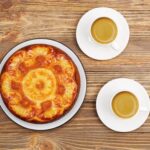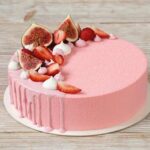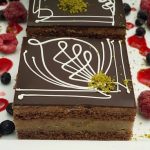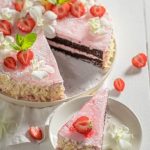Are you wondering, “What can I use to practice cake decorating?” Cake decorating is a creative and essential part of the baking process, allowing bakers to express their artistic talents and create beautiful and delicious works of art.
However, mastering the art of cake decorating requires practice and the right tools. In this article, we will explore the essential tools, work surface options, edible and non-edible materials, practice techniques, helpful resources for beginners, and tips for successful cake decorating practice.
Cake decorating involves various techniques such as piping, fondant shaping, floral decorations, and more. It is essential to understand that practice plays a crucial role in perfecting these skills.
The more you practice cake decorating techniques, the better you will become at creating stunning designs on your cakes. Whether you are a beginner looking to improve your skills or a seasoned baker wanting to refine your techniques further, this guide will provide you with valuable insights into what you can use to practice cake decorating effectively.
In the following sections, we will delve into the essential tools for practicing cake decorating, work surface options, edible ingredients for practice, non-edible materials for practice, various techniques to master through practice, helpful resources for beginners seeking guidance in cake decorating, and tips for successful cake decorating practice. By understanding these elements and putting them into practice consistently, you can enhance your cake decorating skills and create visually appealing and professionally finished cakes.
Essential Tools for Practice
To successfully practice cake decorating, it’s essential to have the right tools at your disposal. Whether you’re a beginner or an experienced decorator looking to improve your skills, having the following tools can greatly enhance your practice sessions.
- Piping bags: These are essential for creating intricate designs with icing or frosting.
- Piping tips: Different tips allow for various designs and textures in your decorations.
- Turntable: A rotating turntable makes it easier to ice and decorate the sides of a cake evenly.
- Offset spatula: This tool is perfect for smoothing icing and applying fillings between layers.
- Bench scraper: Ideal for achieving smooth edges on frosted cakes.
- Modeling tools: These are used for shaping and detailing fondant or gum paste decorations.
- Rolling pin: Essential for rolling out fondant or gum paste to the desired thickness.
Having these tools on hand will make your practice sessions more productive and enjoyable. They will also allow you to experiment with different techniques and develop your own unique decorating style.
It’s important to note that investing in quality tools can make a significant difference in the outcome of your cake decorating projects. While it’s possible to start with basic equipment, as you progress, consider upgrading to more professional-grade tools for better results. Additionally, proper maintenance and cleaning of these tools is crucial to ensure they remain in good condition for long-term use.
Work Surface Options
When it comes to practicing cake decorating, having the right work surface options can make a big difference in your ability to hone your skills. Here are some essential work surface options that you can use to perfect your cake decorating techniques:
- Silicone mat: A non-stick silicone mat provides a great surface for rolling out fondant or gum paste without the need for excess flour or confectioners’ sugar.
- Non-stick parchment paper: Parchment paper is a versatile option for creating templates, transferring designs onto cakes, and preventing sticking when working with delicate decorations.
- Cake boards: These sturdy boards provide a stable base for decorating and transporting cakes. They come in various shapes and sizes to accommodate different cake designs.
- Cake decorating turntable: A turntable allows you to smoothly rotate your cake as you decorate, making it easier to achieve even piping and smooth frosting on all sides of the cake.
Having the right work surface options can help ensure that your practice sessions are productive and yield the best results. Whether you’re working with fondant, buttercream, royal icing, or gum paste, these tools will provide the stability and support needed for successful cake decorating practice.
Remember that proper preparation and setup can enhance your overall experience as you learn new techniques and perfect your skills in cake decorating.
So what can I use to practice cake decorating? With the right work surface options at your disposal, you’ll be well-equipped to create beautiful designs and master the art of cake decorating.
Edible Ingredients for Practice
When it comes to practicing cake decorating, having the right edible ingredients is essential. The type of frosting or icing used can greatly impact the overall look and taste of the finished product. One of the most common and versatile options for cake decorating practice is buttercream frosting. This smooth and creamy frosting can be easily manipulated into various designs, making it perfect for practicing piping techniques and creating decorations.
Another popular choice for cake decorating practice is royal icing. This type of icing dries hard and is often used for intricate details and delicate decorations. Royal icing is great for practicing fine lines, intricate designs, and creating 3D effects on cakes.
For those looking to explore more advanced cake decorating techniques, fondant and gum paste are excellent options for practice. Fondant is a pliable sugar dough that can be rolled out and used to cover cakes, create sculpted decorations, and add a smooth finish to baked goods. Gum paste, on the other hand, is a firmer version of fondant that dries quickly and can be molded into intricate shapes such as flowers, figurines, and other detailed decorations.
When wondering what to use to practice cake decorating with edible ingredients, it’s important to consider not only the variety of techniques you want to explore but also your own personal preferences in terms of taste and texture. Experimenting with different types of frosting and icing will not only help you improve your skills but also allow you to discover which mediums you enjoy working with the most.
Non-Edible Materials for Practice
Styrofoam Dummies
When it comes to practicing cake decorating, styrofoam dummies are a popular choice for beginners. These can be used as stand-ins for real cakes, allowing decorators to practice their techniques without wasting ingredients. Styrofoam dummies come in various shapes and sizes, making them versatile for practicing different cake designs.
Practice Boards
Practice boards are essential for mastering cake decorating skills. These boards are typically made of foam or cardboard and provide a stable surface for practicing piping, fondant shaping, and other techniques. They also allow decorators to easily transport and display their practice designs.
Practice Cakes
For those looking to take their practice to the next level, creating actual practice cakes can be beneficial. These are real cakes made specifically for practicing decorative techniques. Practice cakes allow decorators to work on their skills with real ingredients, helping them understand how different types of cake batters and frostings behave during the decorating process.
When it comes to honing your cake decorating skills, using non-edible materials such as styrofoam dummies, practice boards, and practice cakes can help you perfect your techniques before working on actual edible creations. By incorporating these tools into your practice routine, you can develop confidence and precision in your cake decorating abilities.
Practice Techniques
When it comes to practicing cake decorating, there are a variety of techniques that aspiring bakers can use to improve their skills. Piping is one of the most fundamental skills in cake decorating, and having the right tools for this technique is crucial. Beginners should invest in piping bags and tips to practice different designs and patterns. A turntable is also essential for practicing piping techniques, as it allows decorators to easily rotate the cake while piping.
Another important practice technique in cake decorating is floral decorations. For this technique, modeling tools and a rolling pin are essential. These tools can be used to shape fondant or gum paste into intricate flower designs, which can then be used to adorn cakes. Additionally, cake carving is another important skill that requires practice. Beginners can use styrofoam dummies or practice boards to hone their cake carving techniques before working with actual cakes.
Practicing these techniques requires the right work surface options as well. Silicone mats and non-stick parchment paper are useful for rolling out fondant or gum paste, while cake boards provide a stable surface for decorating. A cake decorating turntable also makes it easier to practice various techniques, as decorators can smoothly turn the cake while working on it.
Finally, beginners looking to improve their cake decorating skills should take advantage of helpful resources such as online tutorials, classes, and books. These resources can provide valuable tips and guidance for honing specific techniques and mastering the art of cake decorating.
| Practice Technique | Recommended Tools |
|---|---|
| Piping | Piping bags, piping tips, turntable |
| Floral decorations | Modeling tools, rolling pin |
| Cake carving | Styrofoam dummies, practice boards |
Helpful Resources for Beginners
For beginners looking to improve their cake decorating skills, there are a variety of helpful resources available to assist in the learning process. Whether you prefer online tutorials, in-person classes, or the guidance of informative books, there are options to suit every learning style and preference.
Online Tutorials
One of the most accessible and convenient resources for beginners is the abundance of online tutorials available for cake decorating. Websites like YouTube and social media platforms offer countless videos from experienced decorators, providing step-by-step demonstrations of various techniques. These tutorials cover everything from basic piping and frosting techniques to more advanced fondant sculpting and intricate designs. Additionally, many websites offer subscription-based services with access to comprehensive courses and lessons for those seeking more structured guidance.
Cake Decorating Classes
For those who prefer hands-on instruction, enrolling in a cake decorating class can be an invaluable resource. Many local culinary schools, community centers, and specialty baking shops offer classes specifically tailored to beginners. These classes provide the opportunity to work directly with instructors, ask questions, and receive real-time feedback on your work. In addition to learning new techniques, taking a class can also help beginners gain confidence in their abilities and connect with other aspiring decorators.
Cake Decorating Books
Another valuable resource for beginners is the wide selection of cake decorating books available on the market. These books offer detailed explanations of fundamental techniques, as well as inspiration for creative designs. Many include helpful tips and troubleshooting advice for common challenges that arise during practice. Whether you prefer comprehensive reference guides or visually stunning coffee table books filled with beautiful cake creations, there are options suitable for all levels of expertise.
By taking advantage of these helpful resources, beginners can gain a solid foundation in cake decorating and continue to develop their skills over time. With dedication and consistent practice using the essential tools discussed earlier in this article – such as piping bags, turntables, modeling tools – plus working with edible ingredients like buttercream frosting or fondant along with non-edible materials like practice boards or cakes – aspiring decorators can progress from novice to proficient artist in no time.
Tips for Successful Cake Decorating Practice
When it comes to successful cake decorating practice, having the right tools and materials is essential. Piping bags and tips, a turntable, offset spatula, bench scraper, modeling tools, and a rolling pin are all crucial for honing your skills.
These tools will allow you to experiment with different techniques and create a variety of decorations on your cakes. If you’re wondering what can I use to practice cake decorating, investing in these essential tools is a great place to start.
In addition to the essential tools, selecting the right work surface is also important for cake decorating practice. Options such as a silicone mat, non-stick parchment paper, cake boards, and a cake decorating turntable provide a stable and convenient surface for working with your cake and decorations. Having the right work surface can make the process smoother and more enjoyable.
When it comes to edible ingredients for practice, buttercream frosting, royal icing, fondant, and gum paste are must-haves. These ingredients will allow you to experiment with different textures and effects on your cakes. Additionally, non-edible materials such as styrofoam dummies, practice boards, and practice cakes can be used to perfect your skills without wasting precious ingredients.
Using these materials allows you to practice various techniques without the pressure of working on an actual cake. With the right tools and materials in hand, you’ll be well-equipped to embark on your cake decorating journey.
Conclusion
In conclusion, practicing cake decorating is crucial in mastering the art. The use of essential tools such as piping bags, tips, and turntables, along with work surface options like silicone mats and cake boards, provides beginners with the necessary materials to refine their skills. Edible ingredients such as buttercream frosting and fondant, as well as non-edible materials like Styrofoam dummies and practice boards, offer a range of options for honing techniques and developing creativity.
It’s important for beginners to remember that successful cake decorating practice involves patience and consistency. Starting with simple designs and seeking feedback from experienced decorators can help in gradually building confidence and skills. Additionally, making use of helpful resources such as online tutorials, classes, and books allows for continuous learning and improvement.
To aspiring cake decorators wondering “what can I use to practice cake decorating,” it’s clear that there are numerous tools, materials, techniques, and resources available. With determination and dedication to consistent practice, anyone can improve their cake decorating skills over time. So keep practicing, stay patient, and strive for continuous improvement – the results will be worth it in the end.

Welcome to my blog about home and family. This blog is a place where I will share my thoughts, ideas, and experiences related to these important topics. I am a stay-at-home mom with two young children. I hope you enjoy reading it! and may find some helpful tips and ideas that will make your home and family life even better!





